
If you happen to’ve been on the seek for your subsequent TV, you’ve undoubtedly come throughout two acronyms that stand out essentially the most relating to TV sorts — QLED and OLED. And whereas newer TV tech like Samsung’s QD-OLED (extra on that beneath) has been turning some heads currently, for now, QLED and OLED TVs nonetheless rule the roost. However what’s the distinction between QLED and OLED?
Corporations like Samsung, TCL, and Hisense tout the unimaginable brightness of their QLED TVs, whereas LG, Sony, Panasonic, and others brag concerning the spectacular distinction and black ranges of their OLED TVs.
Is that this only a case of electronics corporations utilizing fancy terminology to hype their merchandise, or are there actual variations between QLED and OLED TVs?
The next video comparability from 2021 stays related in the present day.
On this in-depth explainer, we’ll focus on QLED versus OLED, the place these competing show applied sciences come from, how they’re completely different from one another, and what each does properly (and never so properly). We’ll additionally share which one we expect most individuals can be happiest with. Spoiler: it’s OLED TV — however with a couple of caveats you want to pay attention to.
When you’ve settled on which TV tech is best for you, try among the greatest QLED TV offers and the most effective OLED gross sales accessible now.
What’s a QLED TV?
QLED stands for Quantum Gentle-Emitting Diode. In non-geek converse, which means a QLED TV is rather like a daily LED TV, besides it makes use of tiny nanoparticles known as quantum dots to supercharge its colour.
Our quantum dot explainer has the complete story on how these nanoparticles work, however right here’s a condensed model: a standard LED TV makes use of white LEDs as its mild supply. However so-called “white” LEDs in actuality are likely to veer into the blue, pink, or inexperienced components of the spectrum.
When a TV’s colour filter receives lower than full-spectrum white mild, it may possibly’t do its job (exhibiting you the colours you’re meant to see) with accuracy. In a QLED TV, the backlight supply is produced from a layer of blue LEDs, onto which a layer of pink and inexperienced quantum dots are added. These quantum dots will be added with such precision that the red-green-blue combo creates a near-perfect, full-spectrum white mild, with out sacrificing a single nit of brightness. That excellent white mild is strictly what the TV’s colour filter must generate an correct palette of billions of colours you see on a TV display screen.
The expertise was initially launched by Sony in 2013. Shortly after that, Samsung started promoting its personal QLED TVs and established a licensing partnership with different producers, which is why you’ll additionally discover QLED TVs from Vizio, Hisense, TCL, and lots of small manufacturers too. Even Amazon has gotten into the QLED recreation with its newest Omni Fireplace TVs, and so has Roku, with its new line of Roku-made TVs.
As cool as quantum dots are, a QLED TV nonetheless produces mild the identical approach as a daily LED TV: through the use of a backlight made up of a whole bunch (or in some instances 1000’s) of LEDs, with that backlight layer sitting behind an LCD panel layer. The backlight shines via the LCD panel, which in flip shapes that mild into the pictures that you just see on the display screen. It’s these LEDs that give LED TV (and QLED TV) its identify.
The LCD panel — primarily thousands and thousands of tiny shutters that open and shut too shortly to see — at the side of the colour filters, create the image you see by letting simply the correct quantity of sunshine and colour escape and attain your eyes. It’s a intelligent system, but it surely depends on a mixture of dimming the LED backlights and utilizing the shutters to dam the remaining mild to supply correct on-screen blacks — and it doesn’t all the time succeed. We’ll focus on this extra beneath.
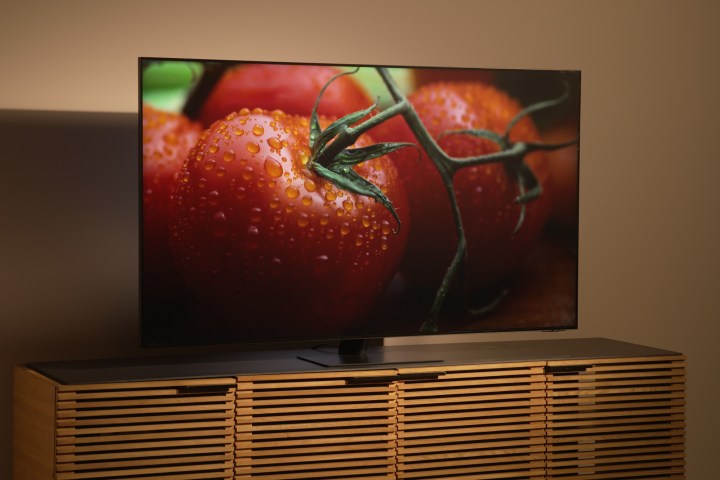
What’s an OLED TV?
OLED stands for Natural Gentle-Emitting Diode. Considerably surprisingly, the “Gentle Emitting-Diode” a part of that identify has nothing to do with an LED backlight. As a substitute, it refers to the truth that each single particular person pixel in an OLED panel is a teeny-tiny LED mild — however one that’s extremely skinny and may produce each mild and colour in a single ingredient. In different phrases, OLED TVs don’t want a backlight as a result of every OLED pixel produces its personal mild. If you wish to impress your mates, you should use the business phrases for these sorts of shows: emissive or self-emissive.
There are a number of benefits to this design, however most individuals would agree that relating to OLED TVs, the largest benefit is the very good black degree that may be achieved. In contrast to a QLED or LED TV that should dim its backlight and block the remaining mild for darkish or pitch-black scenes, an OLED TV merely turns off the pixels that make up the darkish components of the display screen. When the pixel is off, it emits no mild and no colour, making it as darkish as when the TV itself is turned off.
Just one firm makes conventional OLED TV panels: LG Show. It sells these panels to its sister firm, LG Electronics, which makes use of them to construct among the easiest TVs you should purchase. However LG Show additionally sells OLED panels to corporations like Sony, Vizio, Philips, and Panasonic, which is why you’ll see OLED televisions from these corporations, too. Regardless that the panels themselves are primarily an identical, the picture processing that Sony, LG, and others do is proprietary, so that you’ll nonetheless see variations in image high quality from one OLED TV to a different.
Nevertheless, LG Show has not too long ago been joined by Samsung, which now has its personal model of OLED expertise, the aforementioned QD-OLED. It’s not fairly the identical expertise, and whereas it does use what Samsung calls “self-illuminating LEDs,” Samsung makes use of OLED expertise slightly in another way, and we’ll get to that in a second.

What’s mini-LED TV?
As you learn up in your new TV choices, you would possibly see some merchandise touting mini-LED expertise. It might sound like a competitor to QLED and OLED, but it surely’s truly simply an enchancment of the LED backlighting utilized by QLED and LED TVs.
Mini-LEDs are tiny when in comparison with common LEDs. Which means a QLED TV that would usually accommodate a whole bunch of LEDs can now accommodate tens of 1000’s of mini-LEDs. The consequence? Far more management over backlighting, resulting in black ranges that come far nearer to OLED than any non-OLED show has ever achieved.
In late 2019, TCL began promoting the 8-Sequence, the very first QLED TV powered by a mini-LED backlighting system.
In 2023, mini-LED is now mainstream. Along with TCL, you’ll discover mini-LED TVs from Samsung (beneath its “Neo QLED” moniker), LG (which manufacturers these fashions as “QNED“), and Sony, which claims that its mini-LED TVs are superior to all others because of its unique backlight management expertise.
QLED vs. OLED TVs: What are the important thing variations?
QLED TVs come out on high on paper, delivering a better brightness, longer life span, cheaper price tags, and no threat of burn-in. OLED TVs, however, have a greater viewing angle, deeper black ranges, use much less energy, are killer for gaming, and would possibly shield your potential to get a superb night time’s sleep. Each are improbable, although, so selecting between them is subjective. QLED is the higher all-rounder, however OLED expertise excels when you’ll be able to management your room’s lighting.
QLED vs. OLED TVs: Which one is best?
Now, let’s evaluate QLED to OLED within the classes that matter most when shopping for a TV: brightness, distinction, viewing angles, and different notable efficiency issues. All of those are vital elements once you’re shelling out massive cash for a brand new TV.
Black ranges and distinction
Distinction is the distinction between the darkest a part of a picture and the brightest half. If a TV can ship a very black darkish portion, it doesn’t must make the brilliant components fairly as vibrant to realize good ranges of distinction. That’s why, relating to black ranges, OLED reigns because the undisputed champion — due to its potential to go utterly black when it must.
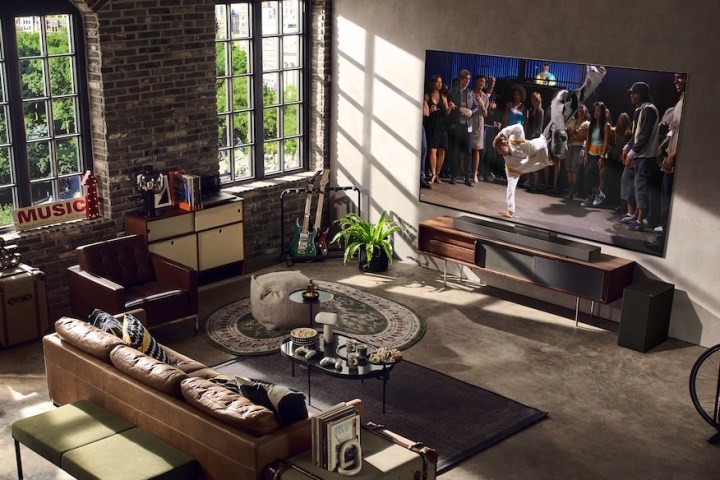
QLED TVs, in contrast (ahem), are pressured to dim their LED backlights and block the remaining mild, one thing that may be very arduous to do completely. It could actually set off one thing known as “mild bleed,” as the sunshine spills from a vibrant space onto what’s imagined to be a black part of the display screen.
However is it noticeable? Positively. If you happen to’re watching an intense motion film and two characters are working via a car parking zone at night time, for instance, it’s possible you’ll discover a slight glow on components of the scene which can be imagined to be pitch black or within the letterbox bars on the high and backside of the display screen whereas watching a film that makes use of a wider than 16:9 side ratio.
As we highlighted earlier, mini-LED backlights are a technique QLED TV makers are attempting to enhance this case. It has actual potential, however we’re not fairly able to declare it an OLED killer.
For now, OLED comes out on high. If an OLED pixel isn’t getting electrical energy, it doesn’t produce any mild and due to this fact stays completely black.
Winner: OLED
Brightness
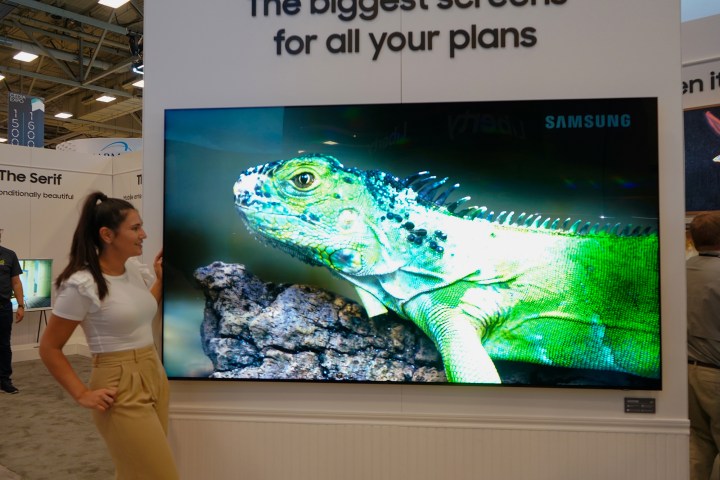
QLED TVs have a substantial benefit relating to brightness. As a result of they use separate backlights (as an alternative of counting on every pixel to create its personal mild), these LED backlights will be made extremely, achingly vibrant — greater than vibrant sufficient to be seen clearly in even essentially the most brightly lit rooms.
OLED panels can’t compete on a pure brightness foundation. Their light-emitting particular person pixels merely can’t produce the identical quantity of sunshine. In a darkish room, this isn’t an issue. Actually, we’d argue it’s preferable as a result of OLED can obtain the identical distinction with much less brightness, making viewing in a darkish room a much less retina-searing expertise. (That’s along with being that a lot simpler in your energy invoice.) However in well-lit environments, or the place plenty of daylight streams in via home windows, QLED TVs are extra seen — particularly should you’re enjoying HDR content material beneath these situations.
OLED panels have turn out to be a lot brighter through the years, and the perfect fashions are actually capable of maintain their very own in vibrant rooms, however they nonetheless can’t match QLED TVs for peak brightness.
When Samsung Show’s QD-OLED was introduced, we anticipated that these TVs would increase the OLED brightness bar, however surprisingly, LG Show has managed to enhance its conventional OLED expertise at the same tempo — there’s primarily no brightness benefit when evaluating the newest LG OLED to the newest Samsung QD-OLED. Take a look at our full head-to-head analysis of the LG G3 versus the Samsung S95C to get all the particulars.
Winner: QLED
Colour house
OLED as soon as blew all of the competitors out of the water on this part, however using quantum dots in QLED TVs has allowed it to inch ahead by way of colour accuracy, colour brightness, and colour quantity, in accordance with Samsung, which claims {that a} wider vary of better-saturated colours at excessive brightness ranges is a bonus.
Whereas there’s no denying the truth that these quantum dot TVs ship improbable colours, we’ve but to witness better-saturated colours at excessive brightness ranges ship an actual benefit in regular viewing conditions — so we’re going to declare it a draw for now. We’ll have to see some tangible proof to declare QLED a winner.
Winner: Draw
Response time, enter lag, and refresh price
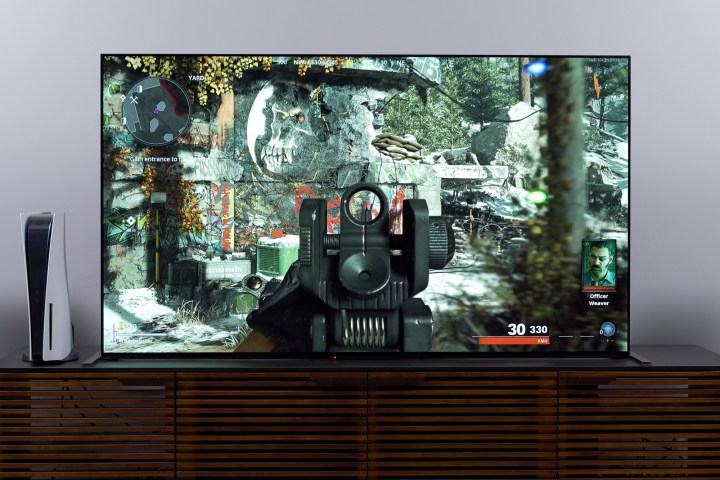
Response time refers back to the time it takes for a pixel to change from one state to a different. The sooner the response time, the crisper the picture, particularly throughout quick motion scenes. Although there may be seemingly a velocity of response time past which the human eye is incapable of telling a distinction, we all know from standardized measurements that OLED TVs are approach sooner — orders of magnitude sooner than QLED TVs.
Typical QLED response occasions differ between 2 and eight milliseconds, which sounds fairly good till you notice that OLED’s response time is about 0.1 milliseconds. Yup, it’s no contest.
Enter lag, however, refers back to the delay between taking an motion (like urgent a button on a recreation controller) and seeing the results of that motion onscreen. As such, enter lag is actually solely a priority for players — it doesn’t have a noticeable impact on the passive viewing of content material in any respect.
Furthermore, the quantity of enter lag you expertise has little to do with one show expertise over one other, however extra to do with how a lot picture processing is occurring in your TV behind the scenes. Each QLED and OLED TVs can obtain very low ranges of enter lag should you flip off all additional video processing or just use the TV’s Sport Mode, which successfully does the identical factor.
Refresh price is one other class that can inherently matter extra to players than informal viewers. The refresh price is the variety of occasions per second the TV updates what it’s exhibiting onscreen. It’s carefully associated to border price, which is the variety of occasions per second your TV present, film, or online game sends a brand new replace to the TV.
So long as these two charges are shut multiples of one another, e.g. a body price of 30 frames per second and a refresh price of double that (60 Hz), you’ll by no means discover an issue. And since common TV content material like motion pictures and TV reveals are all the time delivered at fixed body charges, that is hardly a priority.
However some video games working on consoles or PCs will change their body price from one scene to a different. To maintain every little thing wanting because it ought to, TVs want a function known as VRR, or Variable Refresh Fee. This lets your TV alter its native refresh price to match these adjustments in body price. In case your TV doesn’t assist VRR, it may possibly trigger some undesirable unintended effects like display screen tearing when used with the sorts of video games that require VRR.
Prior to now, solely OLED TVs provided VRR, however as of 2023, it’s accessible on all kinds of flagship QLED TVs too.
Nevertheless, given OLED’s unbeatable superiority in response time, we’re giving it the win, even when most individuals could by no means discover the distinction.
Winner: OLED
Viewing angle

With QLED screens, the most effective viewing angle is lifeless heart, and the image high quality diminishes in brightness, colour, and distinction the additional you progress aspect to aspect or up and down. Whereas the severity differs between fashions, it’s all the time noticeable — regardless of TV makers’ greatest efforts to eradicate the difficulty.
OLED screens, by comparability, will be seen with no luminance degradation even at drastic viewing angles — as much as 84 levels. The most recent OLED fashions, which benefit from microlens array (MLA) expertise, go even additional, as much as an astonishing 160 levels.
Some QLED TVs have improved by way of viewing angle, with anti-reflective layers serving to, however OLED maintains a transparent benefit. So should you like to rearrange household screenings of your favourite motion pictures and wish to ensure there isn’t a nasty seat in the home, an OLED TV is greatest for you.
Winner: OLED
Dimension
OLEDs have come a good distance. When the tech was nonetheless nascent, OLED screens maxed out at 55 inches. In the present day, you should purchase OLED TVs as giant as 97 inches and QLED TVs as much as 98 inches in measurement. OLED nonetheless tends to be costlier as display screen sizes go up however QLED now not has the monopoly on extra-large shows.
Winner: Draw
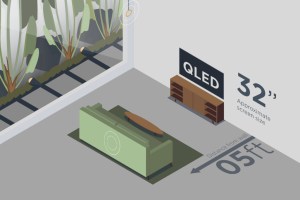
Life span
LG says you would need to watch its OLED TVs 5 hours per day for 54 years earlier than they fell to 50% brightness. Whether or not that’s true stays to be seen, as OLED TVs have solely been out within the wild since 2013. QLED is even newer, however its supply of backlighting — the LED — has a protracted and confirmed monitor file. For that cause and that cause solely, we’ll award this class to QLED.
Winner (for now): QLED
Display burn-in

Each QLED and OLED TVs can sometimes exhibit one thing known as picture retention. That is when a TV briefly continues to show a part of a picture after the unique picture has disappeared. It often presents itself as a sort of shadow — that’s when it presents itself in any respect.
When picture retention happens, it’s often the results of having the identical visible ingredient onscreen for lengthy durations of time. Community logos within the nook of the display screen have been identified to trigger it, as can video video games that current the identical interface parts all through gameplay.
Picture retention sometimes goes away by itself as soon as you turn to another sort of content material that doesn’t present the problematic on-screen parts.
Due to their self-emissive nature, OLED TVs are additionally vulnerable to the a lot rarer everlasting model of picture retention often called “burn-in.” Burn-in is prompted when a number of OLED pixels have their regular brightness completely diminished to a decrease state. The one repair for that is to decrease all the remainder of the pixels to the identical state, however that’s hardly a superb resolution.
LG, as the largest maker of OLED TVs, acknowledges the potential for picture retention inside its person manuals for its OLED TVs however says that beneath regular viewing situations, it shouldn’t occur. LG and Samsung have had beef over their panels’ burn-in potential through the years, most not too long ago over Samsung’s new QD-OLEDs.
So what constitutes “regular” viewing situations? Properly, for one factor, conserving your TV on the identical channel for 10 hours a day, two months in a row, is outwardly not regular.
Ought to this scare you away from shopping for an OLED TV? Completely not. However should you’re selecting a TV to be used as a business show in a retailer or maybe in a ready room or a gymnasium, or should you assume you’ll use it to play the identical online game solely for months at a time, it’s undoubtedly one thing to pay attention to.
For an absolute assure that you just gained’t expertise burn-in, your greatest wager is QLED TV.
Winner: QLED
Energy consumption
As you’re now very a lot conscious, OLED panels don’t require a super-bright backlight. These backlights devour a good quantity of energy, which suggests OLED TVs are inherently extra energy-efficient. In addition they emit much less warmth than QLED TVs.
Within the coming years, OLED’s benefit on this space could widen even additional as new kinds of OLED materials are launched which can be able to changing electrical energy into mild with far better effectivity.
Winner: OLED
Eye consolation

In in the present day’s viewing age, it’s doable to spend hours looking at TV screens with few breaks in between. Eye fatigue is an actual symptom of the act, and it’s often attributable to extreme blue mild manufacturing. LED-based units have a tendency to point out extra intense blue mild than OLED TVs, and that is true even in scenes that don’t function gobs of the shade.
Is blue mild truly unhealthy for you? It is determined by who you ask. Based on the American Academy of Opthalmology, there is no such thing as a scientific proof that blue mild from digital gadgets causes harm to your eye. Nevertheless, there look like good causes to assume that we should always restrict our publicity to blue mild at sure occasions of the day due to the way it impacts our sleep-regulating melatonin manufacturing.
German security testing agency TÜV Rheinland has created its Eye Consolation Show certification as a option to determine shows that keep away from three problematic areas: flicker, reflection, and blue mild emission, every of which may trigger eye pressure. In the mean time, solely LG’s OLED panels are Eye Consolation Show licensed.
The blue mild debate hasn’t gone unnoticed by Samsung. In 2022, it added an EyeComfort mode (no, it’s not associated to the certification, however we’re sure the identify isn’t a coincidence), which may scale back the quantity of blue mild emitted by the corporate’s QLED TVs.
Winner: OLED
Value
As soon as upon a time, this class could be handily gained by QLED TVs, however OLED TVs have come down in price, and since we’re speaking all-premium right here, comparable QLED TVs price about the identical (or extra, relying on the scale). This 12 months (2023) will see the best variety of OLED-based TVs so far, and as is all the time the case, when manufacturing numbers go up, costs come down. In 2021, LG’s largest, 88-inch OLED TV price $30,000. In 2022, its bigger, 97-inch mannequin prices much less ($25,000).
If you happen to’re buying round and see QLED TVs for affordable — and a few of them are extremely reasonably priced — take into account that, not like OLED TV, there’s a wide array in image high quality with QLED TVs as a result of there are much more variables of their design, image processing, and construct. Solely the very top-of-the-line QLED TVs are equal to OLED in image high quality.
Our winner remains to be QLED, as a result of on a price-per-inch of display screen measurement foundation, it’s nonetheless extra reasonably priced, however that hole is getting smaller yearly.
Winner: QLED
Another factor: QD-OLED
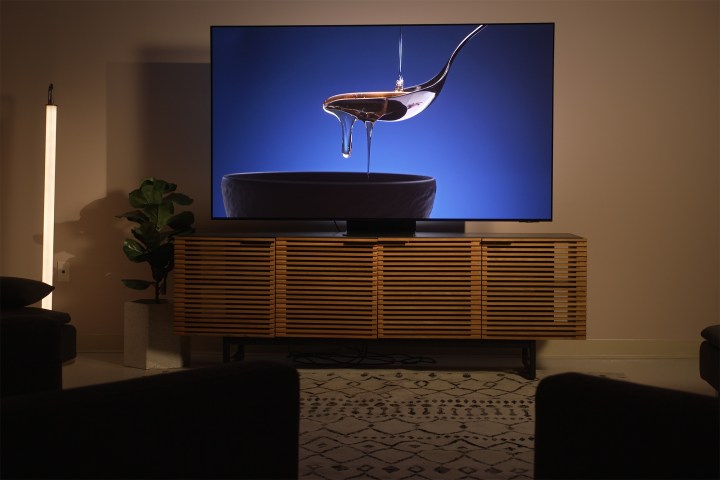
We talked about Samsung’s QD-OLED expertise above, however let’s shortly recap: because the identify suggests, QD-OLED combines OLED show expertise with quantum dots. Our QD-OLED explainer will get into all the (very cool) particulars, however right here’s the 101: QD-OLED preserves all the advantages of OLED that we’ve described above, however is theoretically able to higher brightness and colour accuracy.
Associated
We are able to say, unreservedly, that each QD-OLED TV we’ve examined — together with the Samsung S95B, the Sony A95K, and Samsung S95C — has been nothing in need of spectacular. QD-OLED completely lives as much as the hype. However right here’s the factor: LG’s WOLED panels have been getting higher yearly. They’re so good at this level that should you requested us to decide on between the most effective LG OLED and the most effective Samsung QD-OLED, we’d in all probability do virtually something to keep away from answering. Sure, they’re that shut.
It’s doable that Samsung will be capable to enhance its QD-OLED expertise at a sooner price within the coming years than LG, however till that day comes, we’re simply delighted that TV patrons now have two improbable OLED flavors to select from.
Editors’ Suggestions
Supply Hyperlink : https://selamat.uk/


